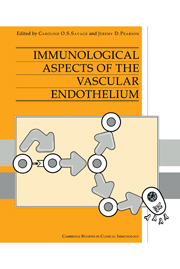Book contents
- Frontmatter
- Contents
- List of contributors
- Preface
- 1 New concepts of mechanisms in autoimmunity
- 2 Regulation of endothelial cell function by cytokines
- 3 Interactions between granulocytes and endothelium
- 4 The regulation of lymphocyte migration by vascular endothelium and its role in the immune response
- 5 Role of the vascular endothelium in immunologically mediated neurological diseases
- 6 The role of the endothelium in systemic lupus erythematosus and Sjögren's syndrome
- 7 The role of the endothelium in rheumatoid arthritis and scleroderma
- 8 The role of the endothelium in systemic vasculitis
- 9 Endothelial involvement in childhood Kawasaki disease
- 10 The role of the endothelium in thrombotic thrombocytopaenic purpura and haemolytic uraemic syndrome
- 11 The immunological role of the endothelium in organ transplantation
- Index
Preface
Published online by Cambridge University Press: 04 August 2010
- Frontmatter
- Contents
- List of contributors
- Preface
- 1 New concepts of mechanisms in autoimmunity
- 2 Regulation of endothelial cell function by cytokines
- 3 Interactions between granulocytes and endothelium
- 4 The regulation of lymphocyte migration by vascular endothelium and its role in the immune response
- 5 Role of the vascular endothelium in immunologically mediated neurological diseases
- 6 The role of the endothelium in systemic lupus erythematosus and Sjögren's syndrome
- 7 The role of the endothelium in rheumatoid arthritis and scleroderma
- 8 The role of the endothelium in systemic vasculitis
- 9 Endothelial involvement in childhood Kawasaki disease
- 10 The role of the endothelium in thrombotic thrombocytopaenic purpura and haemolytic uraemic syndrome
- 11 The immunological role of the endothelium in organ transplantation
- Index
Summary
Endothelial cells form the interface between blood and tissues throughout the body. They are thus the first barrier between cellular or humoral components of the immune system and any challenging extravascular antigen. In recent years it has become apparent that this barrier is far from being metabolically inert, that the properties of endothelial cells contribute critically to the physiological and pathological extravasation of leukocytes, and that these properties can be modulated substantially by inflammatory and immune mediator molecules. In addition, in a subset of autoimmune diseases, vascular damage is prominent, suggesting that immunological effector processes are being targeted inappropriately to the cells of the vessel wall. Similar processes may also underlie rejection of transplanted organs, where donor blood vessels are prominently and primarily affected.
In this volume we have gathered a series of expert authors to describe in more detail the immunological aspects of vascular endothelial cell function summarized above, introduced by a chapter that updates current general concepts of autoimmunity as a framework for what follows. The next three chapters review the ways in which the endothelial phenotype can be modulated by inflammatory and immune cytokines, particularly surveying the recent enormous increase in our understanding of how endothelial cells control leukocyte adhesion and emigration, and of the molecular families implicated in this control. These fall into overlapping but distinct patterns directing the selective emigration of different leukocyte classes in acute or chronic inflammation, and the recirculation of lymphocytes through the lymphyoid tissue.
- Type
- Chapter
- Information
- Immunological Aspects of the Vascular Endothelium , pp. xi - xiiPublisher: Cambridge University PressPrint publication year: 1995



